Nintendo Wii U Teardown
by Anand Lal Shimpi on November 18, 2012 8:07 PM ESTWhen Nintendo announced the Wii U there was a lot of interest in its hardware specs. The new console could very well end up the fastest kid on the block thanks to the sheer age of the Xbox 360 and PlayStation 3. I wasn't all that interested in the Wii U, but I did want to get a look at the silicon inside so I grabbed a unit and went into teardown mode.
The Wii U is available in two versions: the basic and deluxe kits. The basic kit comes in white, while the deluxe is black. Both are glossy. The deluxe console gives you 32GB of on-board storage (eMMC NAND) vs. 8GB for the standard model. The deluxe kit also includes a stand and cradle for the Wii U tablet GamePad as well as a stand for the console itself. The two kits retail for $299.99 and $349.99, respectively.
The Wii U hardware itself looks a lot like a larger Wii. Getting inside the chassis is also quite similar. The CMOS battery door is the first thing you'll have to remove, followed by 8 more screws (a mixture of philips head and tri-wing). The bulk of these screws are behind console-colored stickers, be sure to peel them all off. With all 8 (9 including the CMOS battery door) screws removed, you can slide the left side of the Wii U away from the front of the console, and off all together. This reveals the final three tri-wing screws that you'll need to remove to get inside the chassis (the gallery of all of this is at the bottom of the article).
With all 12 screws removed, pry the top of the Wii U up and away from the body until it separates from the rest of the frame revealing the console's fairly compact internals:
The Wii U optical drive uses a custom format for game storage, but offers a very Blu-ray-like 25GB capacity per disc. Max sequential read speeds are pretty high compared to the current gen consoles at 22MB/s.
Two screws hold the front cover in place, followed by four screws that hold the optical drive in place. Be careful when removing the optical drive as there's a ribbon cable attached to the motherboard for power/data. The same goes for the front cover, although its ribbon cable is really only on light/switch duty.
With the optical drive removed, next up is removing the shielding on the top and bottom of the motherboard and the shround on top of the heatsink. Just go around the perimeter of the motherboard removing screws (you'll be able to remove all but two easily). Once you've done this, the motherboard will be able to separate from the Wii U's lower tray.
Removing the shielding itself requires carefully moving the antenna cables out of the way. As these wires are soldered to the Wii U chassis on one end, be very careful not to pull too hard otherwise you run the risk of needing to break out the soldering iron.
If you've removed all of the screws and freed the antenna wires from their guides a bit, you should be able to pull back the plastic heatsink shroud, revealing...more shielding:
With no screws left to hold it in place however, the shielding is easily dealt with (again pay close attention to the antenna wires). The same is true for the bottom of the PCB.
The two sets of antenna wires go to two independent wireless controllers: one for 802.11b/g/n WiFi, the other to a dedicated 802.11n controller to handle Miracast display streaming between the Wii U and the GamePad display. Thanks to Ryan Shrout over at PC Per for figuring this one out!
Once you've removed all shielding you're left with a pretty clean looking motherboard:
On the top side of the board you'll see the eMMC/NAND package, in this case it's a dual-die Samsung eMMC solution (there's another Toshiba NAND device on the back of the board, not for user storage):
There are four 4Gb (512MB) Hynix DDR3-1600 devices surrounding the Wii U's MCM (Multi Chip Module). Memory is shared between the CPU and GPU, and if I'm decoding the DRAM part numbers correctly it looks like these are 16-bit devices giving the Wii U a total of 12.8GB/s of peak memory bandwidth. (Corrected from earlier, I decoded the Hynix part numbers incorrectly). Our own Ryan Smith found a great reference for the original Wii so we can compare memory frequencies. It looks like the original Wii had a 32-bit wide GDDR3 memory interface running at a max datarate of 1.4GHz for a total of 5.6GB/s of bandwidth (excluding eDRAM).
That doesn't sound like a lot (it's the same amount of memory bandwidth on the Nexus 10 and iPad 3/4), but the Wii U is supposed to have a good amount of eDRAM for both the CPU and GPU to use. Also keep in mind that the Nexus 10 and iPad 3/4 have to drive much higher resolutions than the Wii U does.
The Wii U's MCM is unfortunately covered by a heatspreader, but given that I went through all of this to look at the console's silicon, I was going to look at the console's silicon.
Normally to remove an integrated heat spreader (IHS) you grab a sharp blade and go around cutting the (hopefully) glue around the perimeter of the chip. In the case of the Wii U's MCM, the blades I'd normally use were too thick. A few years ago I decided to give shaving with a double edge safety razor a try. My attempts failed poorly, but I had a stack of unused DE razor blades that were thin enough to get the IHS off.
The trick here is to apply enough pressure to the blade to cut through the glue, as simply trying to saw through the glue will take forever. There are two blobs of glue per side, but if you're trying to remove the IHS be careful not to cut through the glue and scrape any of the actual exposed silicon...like I did.
With the IHS off, we have the Wii U's MCM in all of its glory:
There are actually three components on this single package, made in at least two different microprocessor fabs. The multicore PowerPC based CPU is the smaller of the two larger chips. This die is made on IBM's 45nm SOI process. The RV7xx derived GPU is the biggest die on the package, and I'm presuming it was made on a 40nm process. I'm assuming the very tiny die in the corner is actually some off-chip memory. Both the CPU and GPU in the Wii U are supposed to have some eDRAM, although the bulk of it is likely dedicated for the GPU.
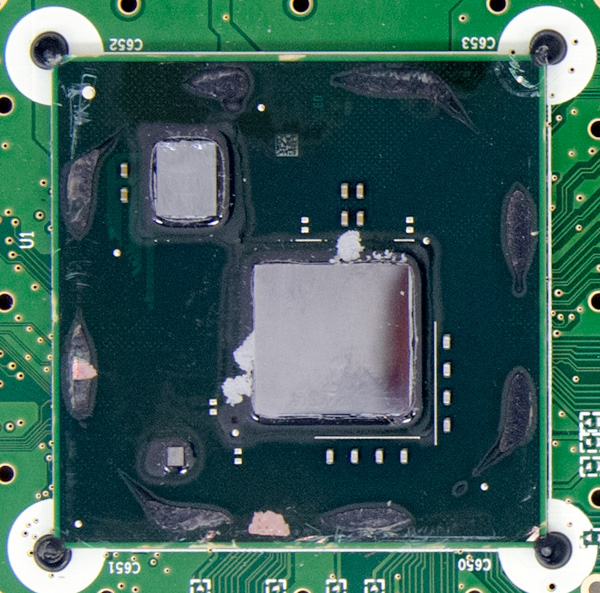
Clockwise from the top: CPU, GPU, off-chip memory?
The approximate die sizes for all components on the MCM are in the table below:
| Wii U Silicon Analysis | ||||
| Dimensions | Approximate Die Size | |||
| CPU | 5.2mm x 6.3mm | 32.76mm2 | ||
| GPU | 12.3mm x 12.7mm | 156.21mm2 | ||
| 3rd die (memory?) | 1.79mm x 1.48mm | 2.65mm2 | ||
If we assume a 40nm process for the GPU, then we're looking at something a bit larger than the RV740. The Wii U does boast backwards compatibility with games made for the original Wii, which is made possible thanks to a shared ISA with the original PowerPC based Wii.
The size comparison between CPU and GPU die shouldn't be too much of a surprise. When building a dedicated gaming machine it always makes sense to throw more transistors at your GPU. The nearly 5x ratio of GPU to CPU die size here is a bit on the extreme side though. I suspect many of the current generation consoles, including the Wii U, suffered from a lack of a powerful yet affordable CPU solution that could be easily implemented.
I also took some power measurements on the Wii U. The system is powered by a 75W external power supply, but total system power consumption doesn't even hit half of that (at least with the games I tried):
| Wii U Power Consumption | ||||
| System Power Consumption in Watts | ||||
| Standby (Power Off) | 0.22W | |||
| Wii U Menu (No Disc in Drive) | 31.2W | |||
| Wii U Menu (Disc in Drive) | 32.8W | |||
| Super Mario U | 33.0W | |||
| Netflix Playback | 28.5W | |||
Rendering the Wii U menu actually consumes almost as much power as playing Super Mario U. Watching a movie on Netflix consumes a bit less power, my guess is a lot of the 3D blocks are power gated leaving only the CPU cores and video decode hardware active.
The Wii U ships with its own web browser based on webkit, the user agent string for the latest version of the Wii U's software is: Mozilla/5.0 (Nintendo WiiU) AppleWebKit/534.52 (KHTML, like Gecko) NX/2.1.0.8.21 NintendoBrowser/1.0.0.7494.US.
Pages load quickly and compatibility is surprisingly decent (HTML5 test: 258 + 4 bonus points). By default you control and view the browser on the GamePad, but you can also choose to display the content on your TV via the console. Scrolling is very smooth and the overall experience is way better than what you'd normally expect from a web browser on what's primarily a game console. It's not quite as good as using a modern tablet, but still usable. And where there is a browser, we will run SunSpider on it:

The browser is using an older version of WebKit, which is likely responsible for some of the not absolutely stellar performance here.


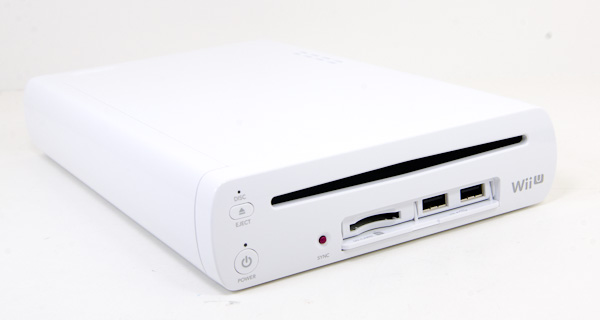

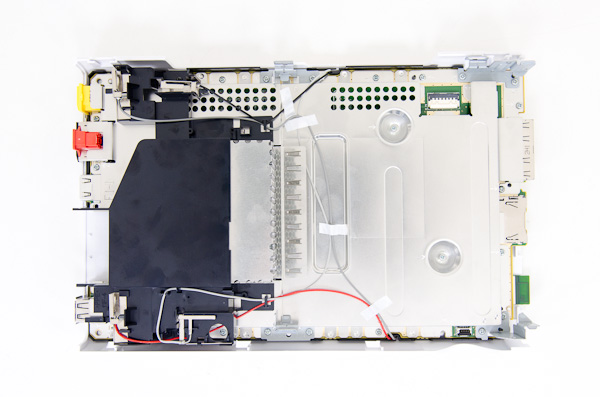
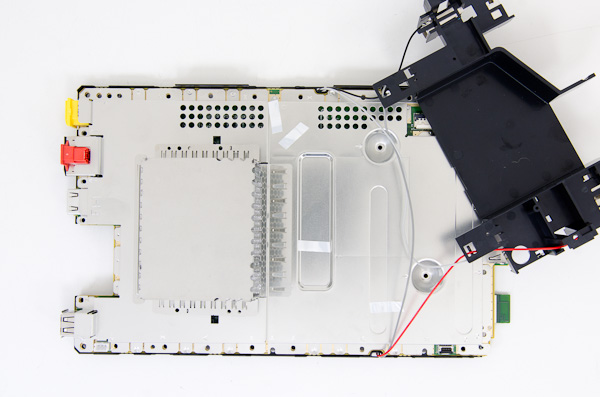
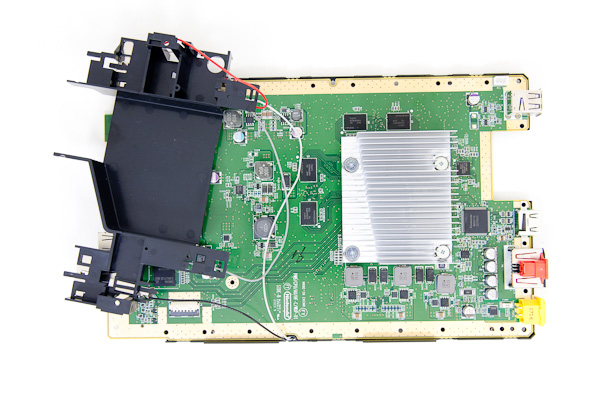
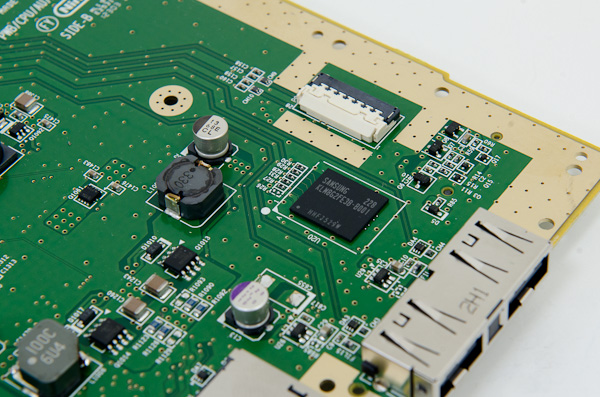

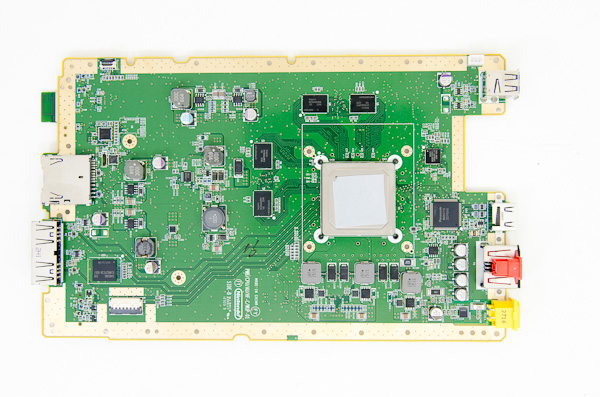















132 Comments
View All Comments
Sniffynose - Sunday, November 18, 2012 - link
And yes the data is in that pdf you linked, the xxC has the exact same specs only there are 2 models 12c (wii u uses) is 800mhz (x2 ddr) and the 11c @900mhz x2 ddrThat's why the sheet has the xxC listing because those are the only differences with that number.
Flyingcircus - Monday, November 19, 2012 - link
thanks for the infoi don't know where you're seeing the 12c speed grade in that pdf however
it didn't even cross my mind that the wii-u might have that much eDRAM
from watching the teardown PCPer did i can confirm that there's no further DRAM ICs on the underside of the PCB (i could identify what i believe to be the SLC NAND chip for the OS that the wii-u is supposed to have and which has been mentioned in this teardown and a bunch of smaller ICs the role of which isn't obvious to me)
http://de.twitch.tv/pcper/b/341042388
minute 18+ is the interesting part
can see the backside of the PCB past minute 20
this much eDRAM seems odd however.. the GPU die doesn't seem big enough to even hold that much embedded memory
Flyingcircus - Monday, November 19, 2012 - link
nevermind i read the other comments now (should have done that before d'uh)not exactly a great outcome
tipoo - Monday, November 19, 2012 - link
I don't think there is dedicated video memory, just the unified memory pool + the eDRAM, sort of like the 360.Sniffynose - Sunday, November 18, 2012 - link
Those Hynix chips are H5TQ4G63MFR-12C Clock Freq 800mhz 1.6gbps/pin 96ball FBGA chips, here's the interesting part nobody has caught onto yet...They are 256mb x16 chips... so x 4 chips in the array we are looking at 1Gb total ram... so unless 4 more are hiding underneath, the video ram is somewhere else, and this ram is the ram being used by the O/S which is fine seeing as most pc's today use ddr3 1600mhz for O/S use...
What is on the underside??? In any case your estimate of 4GB (512mb) per chip is flat out wrong, as they are 256mb per chip with that model number.
If there are none below, then this might mean that the video ram is that small extra chip near the gpu/cpu and that the system ram is separate from video ram like a proper gaming pc would be per se. Which would debunk the ram bandwidth being slow etc theory, because if there is only 1Gb of the ddr3 present this is the ram nintendo said would be reserved for o/s and system use only and not be available to developers.
Ryan Smith - Sunday, November 18, 2012 - link
4Gb is the right density for those chips. We have the specific Hynix datasheet that confirms it.http://www.hynix.com/inc/pdfDownload.jsp?path=/dat...
Sniffynose - Sunday, November 18, 2012 - link
It's not possible as they only manufacture 256mb x16 bus width under that part number. If the chips were 512mb each they would be the x8 bus width 78ball FBGA type.Sniffynose - Sunday, November 18, 2012 - link
Use this data sheet, not the generic one http://goo.gl/itla1Ryan Smith - Monday, November 19, 2012 - link
I will say it again: we have a Hynix datasheet with that specific part number on it, and it is specifically listed as being 4Gbit. So if you have a problem with the size, take it up with Hynix.Sniffynose - Monday, November 19, 2012 - link
I just think you are having a problem with basic math, 256mb x16 bus width per die chip means that the entire ram allocated is 1GB total. There is no 4GB on the wii u to begin with so tooting that number makes you look insane. Nintendo said themselves that 1GB would be dedicated to the O/S (From what we can see those hynix chips) and 1GB for developers that is 2GBBut hey it's not the first time in this article alone you guys have posted wrong technical data.
It's as bad as neogaf claiming the samsung chip was the system ram originally, turns out that was the 8GB eMMC chip aka the built in hard drive...